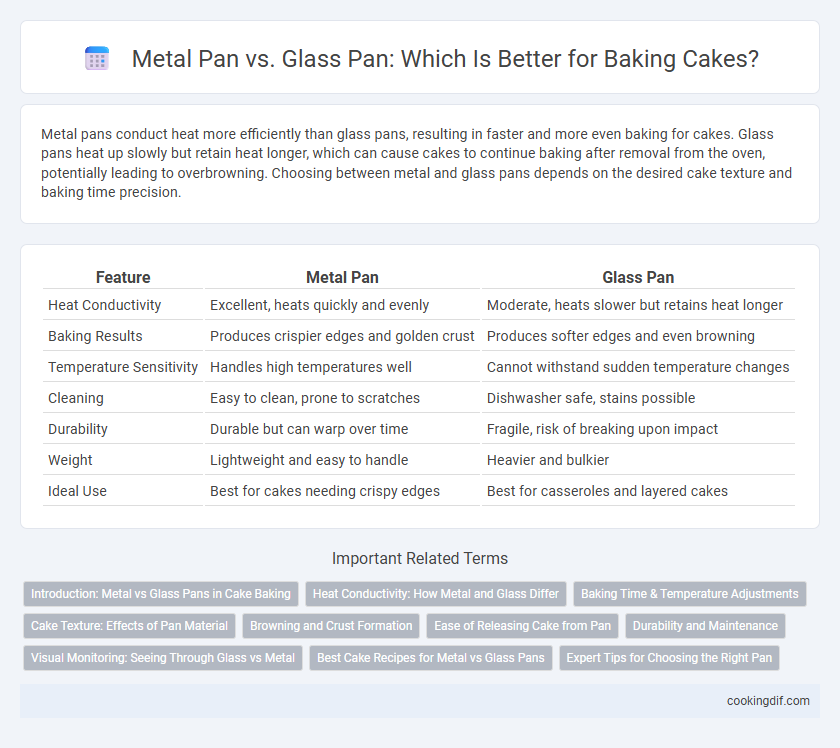Metal pans conduct heat more efficiently than glass pans, resulting in faster and more even baking for cakes. Glass pans heat up slowly but retain heat longer, which can cause cakes to continue baking after removal from the oven, potentially leading to overbrowning. Choosing between metal and glass pans depends on the desired cake texture and baking time precision.
Table of Comparison
| Feature | Metal Pan | Glass Pan |
|---|---|---|
| Heat Conductivity | Excellent, heats quickly and evenly | Moderate, heats slower but retains heat longer |
| Baking Results | Produces crispier edges and golden crust | Produces softer edges and even browning |
| Temperature Sensitivity | Handles high temperatures well | Cannot withstand sudden temperature changes |
| Cleaning | Easy to clean, prone to scratches | Dishwasher safe, stains possible |
| Durability | Durable but can warp over time | Fragile, risk of breaking upon impact |
| Weight | Lightweight and easy to handle | Heavier and bulkier |
| Ideal Use | Best for cakes needing crispy edges | Best for casseroles and layered cakes |
Introduction: Metal vs Glass Pans in Cake Baking
Metal pans conduct heat quickly and promote even browning, making them ideal for cakes that require a crisp crust and precise edges. Glass pans heat more slowly but retain heat longer, yielding cakes with a moist texture and uniform baking, especially for dense batters. Choosing between metal and glass depends on the desired cake texture and baking time, with metal preferred for lighter, airier cakes and glass favored for richer, denser varieties.
Heat Conductivity: How Metal and Glass Differ
Metal pans offer superior heat conductivity compared to glass pans, allowing for faster and more even heat distribution during cake baking. Glass pans heat more slowly and retain heat longer, which can sometimes cause cakes to brown unevenly or cook at a slower rate. Understanding these differences helps bakers choose the appropriate pan to achieve desired cake texture and doneness.
Baking Time & Temperature Adjustments
Metal pans conduct heat more efficiently than glass pans, resulting in faster baking times and the need to reduce oven temperature by 25degF to prevent over-browning. Glass pans retain heat longer, which can cause cakes to continue cooking after removal from the oven, so it's recommended to lower baking temperature and check doneness earlier. Adjusting baking time by shortening it for metal pans and slightly extending it for glass pans ensures consistent cake texture and even baking.
Cake Texture: Effects of Pan Material
Metal pans conduct heat more efficiently than glass pans, resulting in evenly baked cakes with a crispier crust and tender crumb. Glass pans heat more slowly and retain heat longer, often causing cakes to brown faster on the edges while remaining softer inside. Choosing between metal and glass pans significantly influences cake texture, with metal providing a firmer structure and glass yielding a moister, denser bite.
Browning and Crust Formation
Metal pans conduct heat efficiently, promoting faster browning and a crisper crust due to their high thermal conductivity. Glass pans heat more slowly and evenly, resulting in a gentler browning process and a thicker, softer crust formation. Choosing between metal and glass pans depends on the desired crust texture and baking speed for optimal cake results.
Ease of Releasing Cake from Pan
Metal pans, especially those with non-stick coatings, provide superior ease when releasing cakes due to their smooth surfaces and even heat distribution, which helps form a consistent crust. Glass pans, while visually appealing, often retain heat longer and can cause cakes to stick more, requiring thorough greasing or the use of parchment paper to prevent damage during removal. Experienced bakers frequently prefer metal pans to ensure clean edges and seamless cake extraction, reducing the risk of breakage.
Durability and Maintenance
Metal pans offer superior durability with resistance to dents and warping, making them ideal for frequent cake baking. Glass pans, while more fragile, provide excellent heat retention and even baking but require careful maintenance to avoid scratches and breakage. Regular hand-washing and avoiding sudden temperature changes extend the lifespan of glass pans, whereas metal pans withstand more rigorous cleaning methods.
Visual Monitoring: Seeing Through Glass vs Metal
Glass pans offer clear visibility during baking, allowing precise monitoring of browning and doneness without opening the oven. Metal pans, being opaque, require relying on time and scent cues, making it harder to visually assess cake progress. Visual monitoring with glass pans reduces the risk of under- or overbaking, ensuring more consistent cake results.
Best Cake Recipes for Metal vs Glass Pans
Metal pans conduct heat faster than glass, making them ideal for recipes requiring crisp edges and a golden crust, such as chocolate or carrot cakes. Glass pans heat more evenly but retain heat longer, which suits moist, dense cakes like banana or pumpkin varieties that benefit from slower, steadier cooking. Choosing the right pan material enhances texture and baking time, ensuring the best results for specific cake recipes.
Expert Tips for Choosing the Right Pan
Metal pans provide excellent heat conduction, resulting in evenly baked cakes with crispier edges, making them ideal for recipes requiring precise temperature control. Glass pans allow for slower, more even heat distribution, preventing over-browning and are perfect for dense cakes that need thorough cooking. Experts recommend using metal pans for lighter, airy cakes and glass pans for moist, heavier batters to achieve optimal texture and flavor.
Metal pan vs Glass pan for cake baking Infographic

 cookingdif.com
cookingdif.com